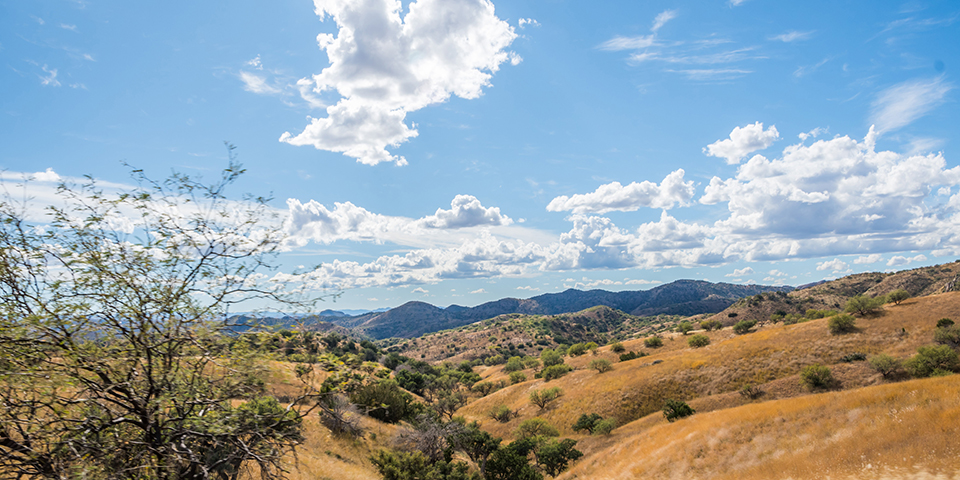ARIZONA
These six Grand Canyon State destinations will take your breath away. Explore history as deep as the canyons and discover treasures that will make you see the American Southwest with new eyes.
Benson
A railroad town brimming with the spirit of the American West, visiting Benson is like stepping back in time. History buffs will love the festivals, museums and historic downtown, while outdoors adventurers have the chance to go even deeper into the past at Kartchner Caverns State Park. With almost perfect year-round weather and picturesque views in all directions, it’s hard to beat a stay in the heart of Cochise County. Enjoy the town’s creativity, then go an a trip to the sights in outlying areas.
Stagecoach Festival
Once part of the historic Butterfield Overland Mail Route, Benson is no longer a stopover for stagecoaches, but you can still enjoy that historic era each October as part of the weekend-long Butterfield Stagecoach Days festival. The event features unique and immersive exhibits like teatime with the Cameo Ladies of Tombstone, rockabilly and mariachi bands, as well as costumed reenactors.
Kartchner Caverns State Park
When it comes to compelling attractions, there’s no place on earth quite like Kartchner Caverns. Discovered in 1974 by two explorers, the caverns have become one of the most popular attractions in the entire state. Home to some of the world’s largest cave formations, the site is both a must-see for tourists and an active research space, where scientists are conducting detailed surveys of the animals and microbes that call the underworld gem home. Tours are led by trained guides and available throughout the year.
Cochise Stronghold
Another kind of wonderland exists just 35 miles east of Benson. Known as the Cochise Stronghold, the stunningly beautiful woodland landscape was once home to the legendary Apache chief, Cochise, and his people. Today, you can explore the steep domes, sheer cliffs and juniper forests along a series of well-maintained trails. The 5-mile Cochise Indian Trail winds through the Stronghold canyon and connects to other nearby trail systems so you can easily extend your route. Horseback riding is also a great option for exploring the backcountry. For a more leisurely visit, try the short Interpretive Trail that leaves from the campground or the half-mile long Nature Trail, both of which offer superb views and historical information on the region and its inhabitants.
Quaint Downtown
With all there is to see and do in Cochise County, it would be easy to forget that simply wandering Benson’s historic downtown is a joy in itself. Your first stop should be the replicated train depot that celebrates the town’s legacy as a stop on the iconic Southern Pacific Railroad. Try the family-friendly train simulator for a chance to experience the thrill of conducting your own locomotive. From there, the Benson Historic Walking Tour directs you to historic homes, mercantiles, hotels and the Benson Museum, all of which bring to life the Old West flair of this classic southwest stopover.
Regional Recipe
Pressure Cooker Chicken Fajitas
Cook up some Arizona flavor with this tasty dish. Recipe by Kate Dunbar.

Getty Images
Ingredients:
- 2½-3 pounds boneless, skinless chicken thighs, cut into strips
- 2 tbsp fajita or taco seasoning
- 2 tbsp olive oil
- 2 green bell peppers, cut into ¼-inch strips
- 2 red bell peppers, cut into ¼-inch strips
- 2 yellow bell peppers, cut into ¼-inch strips
- 1 large yellow onion, sliced thin
- 1 tsp granulated garlic
- 1 lime, juiced
- ½ cup water, chicken stock or vegetable broth
- Flour tortillas
Directions:
In a bowl, add chicken strips, 1 tbsp olive oil and 1 tbsp taco seasoning. Toss, cover and set in fridge up to 2 hours. Slice veggies and place in a bowl. Sprinkle the remaining taco seasoning and garlic over the veggies, mix, cover and set in fridge. Add remaining tablespoon olive oil to Instant Pot pressure cooker and set to sauté. Once ready, add in seasoned chicken and cook 2-4 minutes, stirring to sear. Cancel sauté mode and add in veggies, lime juice and chicken stock. Put lid on and lock into place. Select poultry button and cook on high pressure for 6 minutes. When done, press cancel and carefully release steam vent for quick release. Press sauté button and cook chicken and bell peppers on high until most of the liquid is reduced, about 3 minutes. Warm tortillas and enjoy.
Grand Canyon
One look at the Grand Canyon and you’ll know why it was named one of the seven natural wonders of the world. Bursting with dramatic gorges, soaring buttes and multicolored rock faces, this otherworldly landscape is the result of two billion years of geological activity. You can bask in the natural beauty of this UNESCO World Heritage Site at the South Rim, North Rim or West Rim in Grand Canyon National Park.
Epic Lookouts and Sky-High Views
The South Rim is where you’ll find the area’s most famous attraction: Rim Trail. This easy walking path weaves along the canyon’s edge and includes phenomenal lookouts, including Hopi Point and Maricopa Point. If you’d rather drive, cruise on Desert View Drive from Grand Canyon Village and stop for photos at the many viewpoints along the way. For a spectacular bird’s-eye view, opt for a scenic helicopter flight or step out on the Skywalk in the West Rim, a glass-bottomed bridge suspended over 4,000 feet above the canyon floor.
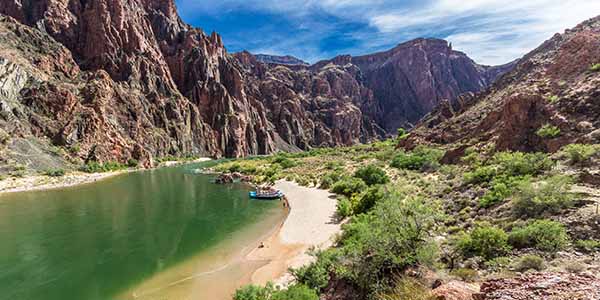
A beach on the Colorado River in the Grand Canyon with rafts and rafters in the distance surrounded by the towering cliffs. At the bottom of the South Kaibab Trail. Nearby is the Black Bridge and Phantom Ranch. The sky is blue with clouds and the river water is green.
Rafting Trip of a Lifetime
Snaking 277 miles through the Grand Canyon, the Colorado River calls on thrill-seekers with its countless rafting opportunities. Most tours depart from Lees Ferry and can range from half-day excursions to week-long trips. You can also choose between motorized or oar-powered trips. If you’re new to rafting, consider a relaxing float trip in the canyon’s northeastern section. Rafters can gaze up at the scenic Granite Gorges and Grand Wash Walls. For the ultimate adrenaline rush, make your way to the westernmost part of the canyon for rougher, wilder waters. Lava Falls and Hump Wave are thrilling stretches of water.
Grand Hikes
Every rim is a hiker’s paradise, thanks to breath-taking vantage points, quiet caves and diverse plant and birdlife. The most popular trek is Bright Angel Trail. Beginning at Grand Canyon Village, this 19-mile stretch takes you through the lush Garden Creek, Inner Gorge and challenging switchbacks called the Devil’s Corkscrew. If sweeping vistas are what you seek, traverse the 14-mile South Kaibab Trail to reach the Ohh Ahh Point and Skeleton Point. For an off-the-beaten-path adventure, head to the Havasupai Tribal Lands for the Havasupai Trail. The ten-mile journey is strenuous but well worth it for the panoramic views of Havasu Falls.
Colorful Gateway Towns
Venture outside the Grand Canyon to find everything from hip enclaves to Route 66 nostalgia. In Flagstaff, wander around the historic downtown where early 20th-century buildings have been converted into galleries, restaurants and watering holes. Make sure to stop by the Museum Club, a taxidermy-turned-bar featuring live country bands. You can also visit the Lowell Observatory, the place where Pluto was discovered. Thirty-three miles west is Williams, home to old-school diners and quirky souvenir stores. Grab a refreshing pint at the Grand Canyon Brewing Co. and admire the Route 66 memorabilia inside Cruiser’s Route 66 Café. The Bearizona Wildlife Park is also located here and gives you a rare chance to come face-to-face with white bison. A two-hour drive from the South Rim brings you to Sedona. The city is famed for its red rock formations and thriving arts scene. Step inside over 80 galleries and then check out the V-Bar-V Heritage Site, the area’s largest rock art site with over a thousand petroglyphs.
Arts and Culture in the Canyon
The Desert View Watchtower in the South Rim regularly hosts free art demonstrations so you can watch tribal artisans create textiles, jewelry, pottery and more. The Grand Canyon Celebration of Art also takes place every September, a six-day event where artists from across the country compete in a “plein air” contest. Their masterpieces are displayed in the Kolb Studio for three months after the competition and then auctioned off. In June, the national park celebrates the annual Star Party by turning into an observatory. Telescopes are set up for public viewing and volunteer astronomers are on hand to share their knowledge.
Ancient Pueblos and Wild West History
Native Americans and intrepid pioneers traversed these lands long before Europeans did and you can hear their tales by attending ranger talks and visiting museums in the South Rim. The Tusayan Ruins act as a window into ancient Pueblo life with excavated rooms and a fascinating collection of pottery, arrowheads and other artifacts dating back thousands of years.
Studio Time
Further west is the Kolb Studio, where the Kolb brothers developed some of the most iconic photos of the Grand Canyon. Today, the family’s legacy lives on with rotating exhibits on history and photography. Over in Williams, the Grand Canyon Railway offers a trip back in time on a restored railcar originally used to transport ore. Board the train to meet eccentric cowboy characters and watch reenacted shootouts between gunslingers while speeding past high desert and prairie terrain.
Mesa/Apache Junction
From spellbinding desert landscapes to fables of undiscovered gold, Mesa and neighboring Apache Junction have long captured the imagination of travelers. The fascination with these two destinations doesn’t stop there. Beyond the stunning scenery and local lore are modern treasures ranging from a vibrant visual arts scene to delicious farm-to-table destinations. It’s hard to resist the mysteries that seem to live in these hills.
Treasured Trails
Stretching 40 miles from Apache Junction to the Theodore Roosevelt Dam, the legendary Apache Trail blends Wild West history with exciting outdoor recreation. Spend your days wandering through recreated boom towns, fishing in bountiful lakes and admiring the vast Sonoran Desert from countless viewpoints. You’ll also want to take a scenic steamboat ride on Canyon Lake and explore Native American cliff dwellings in Tonto National Forest.
In Mesa, a different trail winds through town. Boasting 11 agritourism stops, the Fresh Foodie Trail lets you sample local flavors at wineries, olive farms, urban gardens and more. Highlights include learning how to grow your produce at True Garden and feasting on Arizona-style barbecue at Jalapeno Bucks.
Water Recreation at Your Fingertips
Three lakes and two rivers just outside Mesa open the doors to boating, fishing and all sorts of watersports. Cast a line into Apache Lake, Saguaro Lake or Roosevelt Lake to catch largemouth bass, crappie and catfish. If you’re after rainbow trout, flick your rod into Canyon Lake. Boat rentals are available at all three lakes, along with storage and camping facilities. Salt River is the closest river to town and winds through the Tonto National Forest, making it an excellent destination for kayaking and rafting. Tubing is popular as well, especially in the spring and summer months.

Sunset in Sonoran Desert, near Phoenix.
Desert Playground
The Sonoran Desert has intrigued outdoor enthusiasts for centuries with its canyon-carved lakes, giant cacti and jagged mountains. Usery Mountain Regional Park is a fantastic spot to start your adventure with over 29 miles of trails for hiking, mountain biking and horseback riding. Don’t forget your camera as these pathways end with panoramic views of the valley. Trails within Lost Dutchman State Park lead you into the heart of the Superstition Wilderness and Tonto National Forest, while routes in San Tan Mountain Regional Park promise sweeping vistas of the lower Sonoran Desert.
World-class Art Scene
Get to know the city’s artsy side at the Mesa Arts Center, the largest arts and entertainment complex in the Southwest. You can catch a concert or comedy play at one of the state-of-the-art theatres or view works by renowned artists inside the Mesa Contemporary Arts Museum. The center hosts workshops too, so you can create paintings, pottery and more.
Valley of the Sun
With over 325 days of sunshine per year, the greater Phoenix area is well-deserving of its nickname, the “Valley of the Sun.” The balmy region consists of more than 20 communities, including Phoenix, Scottsdale, Chandler, Tempe, Mesa and Glendale. Each enclave has a distinct flair, allowing you to choose your ideal getaway. From climbing rugged peaks and relaxing at luxurious spas to reliving Wild West history and exploring dozens of world-class museums, adventures in this part of the Sonoran Desert are incredibly eclectic and even more exciting.
Live in Luxury
It doesn’t take long for your stress to melt away here. Sumptuous wellness centers such as the Alvadora Spa and Aji Spa blend soothing treatments with tranquil desert settings so you can leave feeling refreshed and rejuvenated. The area is also home to almost 200 golf courses. Play a round while admiring desert landscapes at Troon North or We-Ko-Pa. Some clubs like Arizona Biltmore even have on-site spas so you can indulge in a therapeutic massage after finishing 18 holes. You can also sip your way through dozens of wineries that cultivate vintages around the Phoenix area. Head to the Verde Valley to swirl fine reds amidst spectacular canyons or go to the Sonoita/Elgin region which is encircled by a national forest. If you prefer to stay in town, pop in Peoria’s Winery 101 to sample bottles from Gallifant Cellars and Southpaw Cellars.
Get on the Water
Beyond the red rocks and cacti are more than 30 lakes and ponds stocked with fish. Locals say you can catch trout in Oak Creek. Lake Pleasant and the Lower Salt River are also top angling spots because of their abundance of largemouth bass, sunfish and catfish. The lakes in Tonto National Forest are worth a visit as well for their ample supply of smallmouth bass, crappie and walleye. Boating, tubing and waterskiing are also popular pursuits here. Back in town, continue the watersports by paddleboarding on Tempe Town Lake, an oasis located in the heart of town.
Outdoor Adventures at Your Doorstep
You’re never too far from a fantastic trail in Greater Phoenix. For the best views of the valley floor, hike the Echo Canyon Trail on Camelback Mountain. The path offers 1,200 feet of elevation gain so you can expect dazzling 360-degree vistas from the summit. For a less strenuous hike that doesn’t sacrifice views, traverse the short Lookout Mountain Summit Trail in the Phoenix Mountains Preserve or the Pinnacle Peak Trail in Pinnacle Peak Park. Mountain biking is big here too, so consider pedaling through easy to challenging trails within Papago Park, South Mountain Park and the McDowell Sonoran Preserve.
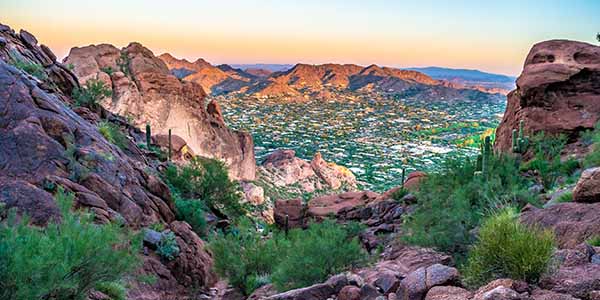
This was a colorful sunrise that I took on Camelback mountain in Phoenix, Arizona
Eclectic Neighborhoods
It’s easy to pursue your biggest passions in the Valley of the Sun. Foodies can dig into innovative fusion cuisine and delicious Mexican fare in Scottsdale. At the same time, artsy folk can feed their creative soul at the Phoenix Art Museum and Roosevelt Row arts district. Naturalists will want to view agave, yucca and other local flora at Papago Park’s Desert Botanic Garden, while history buffs won’t want to miss exploring the Phoenix Police Museum’s exhibits. Architecture enthusiasts are in luck too as Tempe and Scottsdale contain buildings designed by Frank Lloyd Wright himself.
Four Seasons of Fun
Great year-round weather sets the stage for fun events in every season. In March, catch more than 200 baseball games during Cactus League Spring Training and watch big-name performers like Bon Iver and Rüfüs Du Sol perform at M3F Music Festival. Things heat up in the summer with Artlink’s First Fridays Art Walk, one of the country’s largest self-guided art walks with over 70 galleries and venues to explore. The Arizona State Fair, Arizona Taco Festival and Phoenix Fashion Week are in full swing during October, while the NASCAR Semi-Final Race Weekend takes center stage in November. Winter is also an excellent time to come, thanks to family-friendly events like the Arizona Renaissance Festival and Scottsdale Arabian Horse Show.
Hohokam Heritage
Get swept up in the region’s rich past at the Pueblo Grande Museum and Cultural Park. Situated east of downtown Phoenix, this archaeological site was once home to a Hohokam tribe. Learn how the Hohokam dug canals as part of a complex irrigation system. A short trail takes you past a platform mound, ball court and re-created houses, while three galleries showcase artifacts and exhibits related to the village. You can gain even more insight into Native American culture at the acclaimed Heard Museum. Boasting 11 galleries and outdoor courtyards, this beautiful space spotlights traditional and contemporary works by indigenous artists. Stop by the gift shop if you want to bring a piece of original art home.
Verde Valley/Sedona
Humans have inhabited the Verde Valley for over 10,000 years, but that doesn’t mean a visit here is all about the past. New Age spirituality, forward-looking design and a burgeoning wine scene are all a part of a reinvention that has made Sedona and the surrounding communities among the most exciting destinations in the country. Whether you’re a history buff, an outdoor lover, or a bit of both, you’ll find lots to enjoy among the stunning rock formations, verdant forests and cultural scene of a locale once voted the “Most Beautiful Place in America.”
Local Wineries in Verde Valley
A day trip on the Verde Valley Wine Trail is the perfect way to see how local vintners are putting Arizona on the wine-making map. Featuring over 20 wineries and tasting rooms in nearby towns like Jerome, Cottonwood and Page Springs, you can try everything from award-winning blends to sustainably grown local varietals while taking in a diverse array of northern Arizona landscapes. Adventurous wine lovers can even pair an outing with a trip on the endlessly scenic Verde River. Tours include kayaking your way through easy-going rapids while enjoying the sight of bald eagles and other local wildlife, before ending your day with a quick hike to a riverside winery for a tasting led by professional sommeliers.
Sedona Rock Formations, Hiking and Biking Opportunities
Surrounded by a national forest, four wilderness areas and two state parks, Sedona is a veritable paradise for outdoor adventurers. There are endless opportunities for paddling, hiking, biking and climbing, but most visitors come simply for a glimpse of the famed red rocks. These otherworldly sandstone formations glow a brilliant red and orange in the dawn and dusk light. There are hundreds of trails that offer stunning views of the singular landscape, but the 1.2-mile Doe Mountain Trail and the steep, one-mile hike to the top of Cathedral Rock are among the most popular. Mountain bikers should head to the Long Canyon Trail or Mescal Trail for beginner and intermediate routes, respectively.
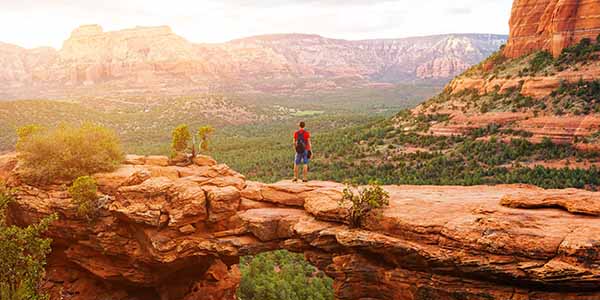
Travel in Devil’s Bridge Trail, man Hiker with backpack enjoying view, Sedona, Arizona, USA
Sedona Chapel of the Holy Cross
One of the most unique sites in the red rocks is the iconic Chapel of the Holy Cross, a Roman Catholic chapel built directly into the buttes that surround it. Featuring a 90-foot iron cross and a steel and concrete frame, the landmark is an unmistakable part of Sedona’s landscape and one of the city’s most visited sites by people of all faiths. Designed by sculptor Marguerite Brunswig Staude, a student of Frank Lloyd Wright, and constructed in 1956, the religious site boasts expansive desert views, but most visitors say the incredible calm they feel touring the wonder is the reason they return.
Montezuma’s Castle
When it comes to wondrous structures, Montezuma’s Castle National Monument in nearby Camp Verde is one of the most spectacularly preserved cave dwellings in the world. The five-story, apartment-like structure consists of more than 40 rooms carved out of an almost sheer cliff face. The amazing will and determination of the Sinagua people, who made a home for themselves in the unforgiving desert, is something to behold. In fact, Teddy Roosevelt was so struck by the site that in 1906 he declared it one of the nation’s first National Monuments. These days, you can join a formal park ranger program to learn more details about the structure and the people who built it, or simply enjoy the scenic and history as you picnic in a sycamore grove at the cliff’s base.
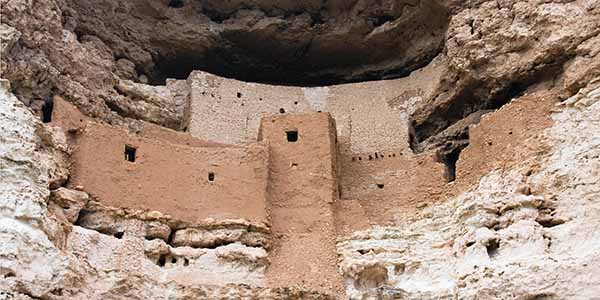
Yuma
Sitting on the banks of the Colorado River, Yuma entices travelers seeking recreation on the current and adventure in rugged landscapes. Surrounding the city, lush, green fields stretch out to the city limits. Yuma has managed to make the most of its location, providing cooling activities in and out of the water, and bundling historic destinations with newfound experiences. From working the blackjack table to dropping a line in a favorite fishing hole, the Gateway of the Great Southwest is a good bet on a great getaway.
Getting Tubular
For many visitors, floating down the current on an inner tube scratches the itch for fun. Visitors can hit the water via boating or paddling canoes and kayaks on the slow current. Several outfitters in town provide the watercraft of your choice. If swimming is more desirable, head to Centennial Beach, or fall hook, line and sinker in love with fishing upstream along the river.
Imprisoned History
One of the city’s top attractions is a grim reminder of the fate of outlaws during the 1800s. Built in 1875, the Yuma Territorial Prison housed inmates for over 30 years, but today the abandoned cell blocks constitute one of the most popular state parks in Arizona. Equally compelling is the Arizona Historical Society Sanguinetti House Museum & Garden, which showcases the residence of E.F. Sanguinetti, a luminary from the early 1900s who was nicknamed the “Merchant Prince of Yuma.” Another popular destination is the Saint Thomas Yuma Indian Mission just across the state line in Winterhaven, California.
Yuma Gets Creative
The Yuma Art Center showcases top performers from across the world. From Dinner Theater to the Battle of the Bands, or the Children’s Ball to Art in the Park, participants have an ever-widening list of events from which to choose. Looking for something wilder? Make a wager on a night of fun at one of the local casinos. Or hit more than 15 golf courses in the area.
Yuma Knows How to Party
Yuma packs its event calendar with exciting festivals and riveting historical events. January brings Civil War Days to the desert with battle reenactments on the grounds of the Colorado River State Historic Park. Occurring mid-November, the Colorado River Crossing Balloon Festival will take visitors up, up and away with daily liftoffs. Yuma certainly rises to the occasion with tethered rides, entertainment and a balloon glow at Desert Sun Stadium.
Taking Wing
Military and civilian aircraft that helped make aviation history are on display during the Yuma Air Show. Usually held in March, the desert skies fill with plane demonstrations, while back on solid ground, attendees will find modern airplanes, helicopters and jet displays, along with entertainment. See the Marine Corps Mounted Color Guard and see the Fireworks Finale.

St. Thomas Mission in Yuma, AZ.
Agriculture Hotspot
The region’s warm climate and proximity to the river make it ideal for agriculture. Yuma County is a thriving farming community that produces over $3 billion a year in winter vegetables and other agricultural products. In fact, a third of Arizona’s agricultural produce comes from the Yuma County area, making it a prime winter snowbird spot for Field to Feast farm tours with gourmet farm-to-table lunches, farmer’s wife dinners, progressive dinners and other special events.
Snowbirds Soar Here
Yuma has shed its roustabout past and now welcomes RVing snowbirds with open arms. With warm winters (and even warmer summers), the region has become a haven for snowbirds looking for balmy winter retreats. The town’s population easily doubles in size, as it offers a warm welcome to more than 85,000 temporary residents. Snowbirds come from as far as Canada to enjoy Colorado River views and the warm desert sun.
Views From Above
The surrounding landscape of Yuma is a vibrant mixture of desert terrain, riparian habitat and rugged mountains. Castle Dome Peak is a distinctive, blocky summit with hidden gullies and solid rock footing that allow experienced hikers a reasonably safe trek up to the top. If you’d prefer not to make the hike, you can enjoy spectacular views of the summit from afar. Bighorn sheep make their home among the peaks and valleys of the Castle Dome Mountains. For a moderate hike, head out to Telegraph Pass Trail, a 2.2-mile round-trip trail east of the city that boasts scenic views for trekkers.
Wild in Yuma
Yuma’s diverse species invite licensed sportsmen to bag big game such as bighorn sheep and mule deer, as well as dove, quail and waterfowl. Cast a line at Fortuna Pond for largemouth bass, channel catfish, bluegill, mullet and carp—seasonally, the pond is also stocked with rainbow trout. Away from waterlogged recreation, Yuma’s untamed terrain beckons daredevils. Imperial Sand Dunes National Recreation Area is open to riders of all-terrain vehicles, campers and hikers. The stark backdrop has served as a setting for “Star Wars,” “Jarhead” and “The Scorpion King.”
The Rush To Riches
Mining success in the 1860s led to the birth of the town of Castle Dome Landing, about one hour north of Yuma along the Colorado River. During its heyday, the population of Castle Dome exceeded the population of Yuma, but when the mines ran dry, the town was abandoned. Today, the ghost town stands as the Castle Dome Mines Museum, and visitors can tour buildings dating back to the 1800s, including a stamp mill, five saloons, a stone cabin and dozens of preserved artifacts from the town’s heyday. Fortuna Mine was another quick boom-and-bust town near Yuma that today is marked by an interpretive trail. The 2-mile trail takes hikers past a stamp mill, a slurry pile, the Fortuna Cemetery and several mine shafts.
In the Army
Can’t get enough history? Dating back to 1864, the Yuma Quartermaster Depot State Historic Park was used by the U.S. Army as a warehouse to store food, clothing and ammunition. Almost a thousand mules surrounded the depot, ready to bring supplies to other military forts nearby. Featuring five historic buildings, this 10-acre park is home to some of the best-preserved architecture in Arizona. While you’re here, be sure to check out the Yuma Siphon exhibit, an extensive tunnel beneath the Colorado River that was completed in 1912 and still brings irrigation water to the Yuma Valley.
Yuma Crossing
Built on the east bank of the Colorado River, Yuma’s past is a colorful mixture of the Wild West mayhem with a bit of railroad and military history thrown in for good measure. The river is a common thread that runs through all of it. Before dams controlled its flow, the Colorado ran wild and free, in some places reaching several miles in width. But the geography of Yuma tamed the beast with granite bluffs containing the river, making it the first dependable crossing in hundreds of miles. This proved to be a perfect place for a settlement, and the population swelled in the 1800s as the California gold rush brought thousands of intrepid treasure hunters through the area on their way to the Golden State.
On the Way to Gold
The Butterfield Overland Mail Stage ran through Yuma Crossing, as did the Mormon Battalion, all using a rope ferry to cross the river. Steamboats came up the Colorado from the Gulf of California, off-loading supplies for army forts that popped up during the Mexican-American War. By the time railroads entered the territory in 1877, the town had a new name: Yuma.
Climb and Hike
The Yuma Valley’s wild and scenic landscapes offer diverse climbing, hiking and biking opportunities for folks who want to work up a sweat. In town, a paved riverfront trail, which runs from Joe Henry Memorial Park to Pacific Avenue, is a great place to stroll, cycle and in-line skate.
Fishing
The Gila River is a small stream for many miles before it flows into the Colorado River northeast of town. It holds a variety of fish and would probably be the best opportunity for a walking fly fisher. Visitors to Yuma can find three points to fish the Colorado River: The Lower River and Laguna Reservoir yield plenty of bass, while the Imperial Reservoir offers a variety.
For More Information
Arizona Office of Tourism
866-275-5816
www.visitarizona.com
Benson Visitor Center
520-586-4293
www.bensonvisitorcenter.com
Grand Canyon National Park
928-638-7888
www.nps.gov/grca
Visit Mesa
800-283-6372
www.visitmesa.com
Greater Phoenix Convention and Visitors Bureau (Valley of the Sun)
877-225-5749
www.visitphoenix.com
Sedona Verde Valley Tourism Council
877-847-4829
www.sedona-verdevalley.com
Visit Yuma
800-293-0071
www.visityuma.com
